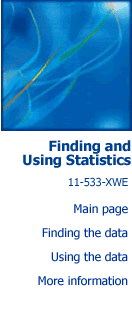
 |
||||||
Information identified as archived is provided for reference, research or recordkeeping purposes. It is not subject to the Government of Canada Web Standards and has not been altered or updated since it was archived. Please "contact us" to request a format other than those available.

|
Symbols, definitions, data sources and methodsUnderstanding symbols Understanding symbolsIn certain circumstances, figures in a table may be accompanied by a symbol (click here for an example). The following standard symbols are used in Statistics Canada products:
*Note: When the figure is not accompanied by a data quality symbol, it means that the quality of the data was assessed to be "acceptable or better" according to the policies and standards of Statistics Canada. More information on Statistics Canada symbols is available at the Standard Table Symbols site. Definitions, data sources and methodsProvided with each Statistics Canada publication, metadata allow users to interpret data more effectively. Metadata—literally, data about data—informs users of the features that affect data quality or fitness for use. The information includes the definitions of the variables and description of their classification schemes, the description of the methodology used in collecting, processing and analyzing the data, coverage and scope of the data, and information on its accuracy. For example, it is very important to know the definition of "Place of Origin" for interpreting immigration data. Is it the place a person is born, the place a person has lived for most of their life, or the last place a person resided prior to moving to Canada? What if the country's boundaries have changed over time, or the name of the country has changed? These issues need to be clearly defined so that data collection is consistent. The information is important when comparing data across surveys or sources of information, and in drawing conclusions regarding change over time, differences between geographic areas and differences among sub-groups of the target populations of surveys. More information is available through the Statistics Canada Definitions, data sources and methods site. In addition, if there are data collection questions when reviewing statistical reports, you can review the original questionnaires as well, either alphabetically or by subject. |
|